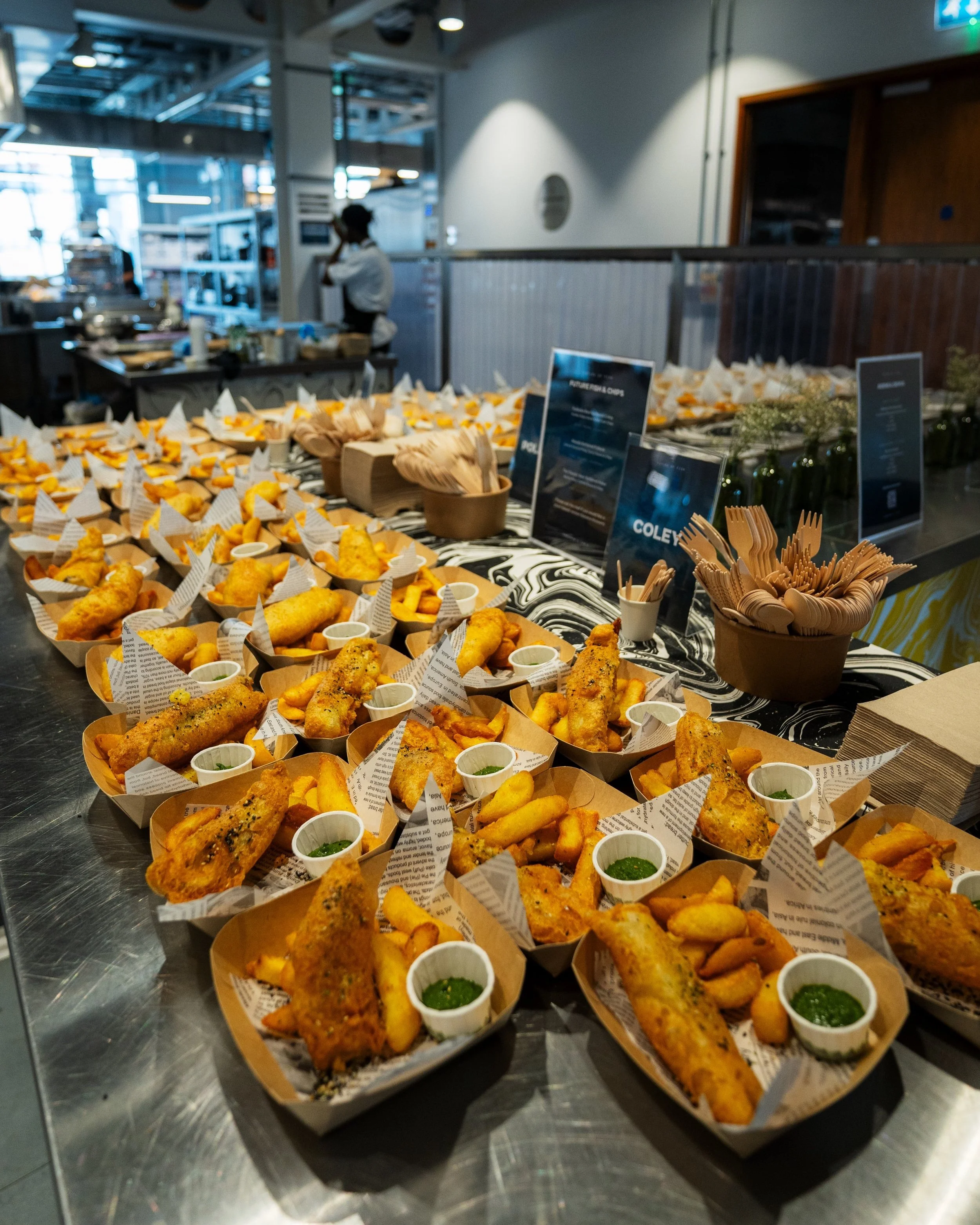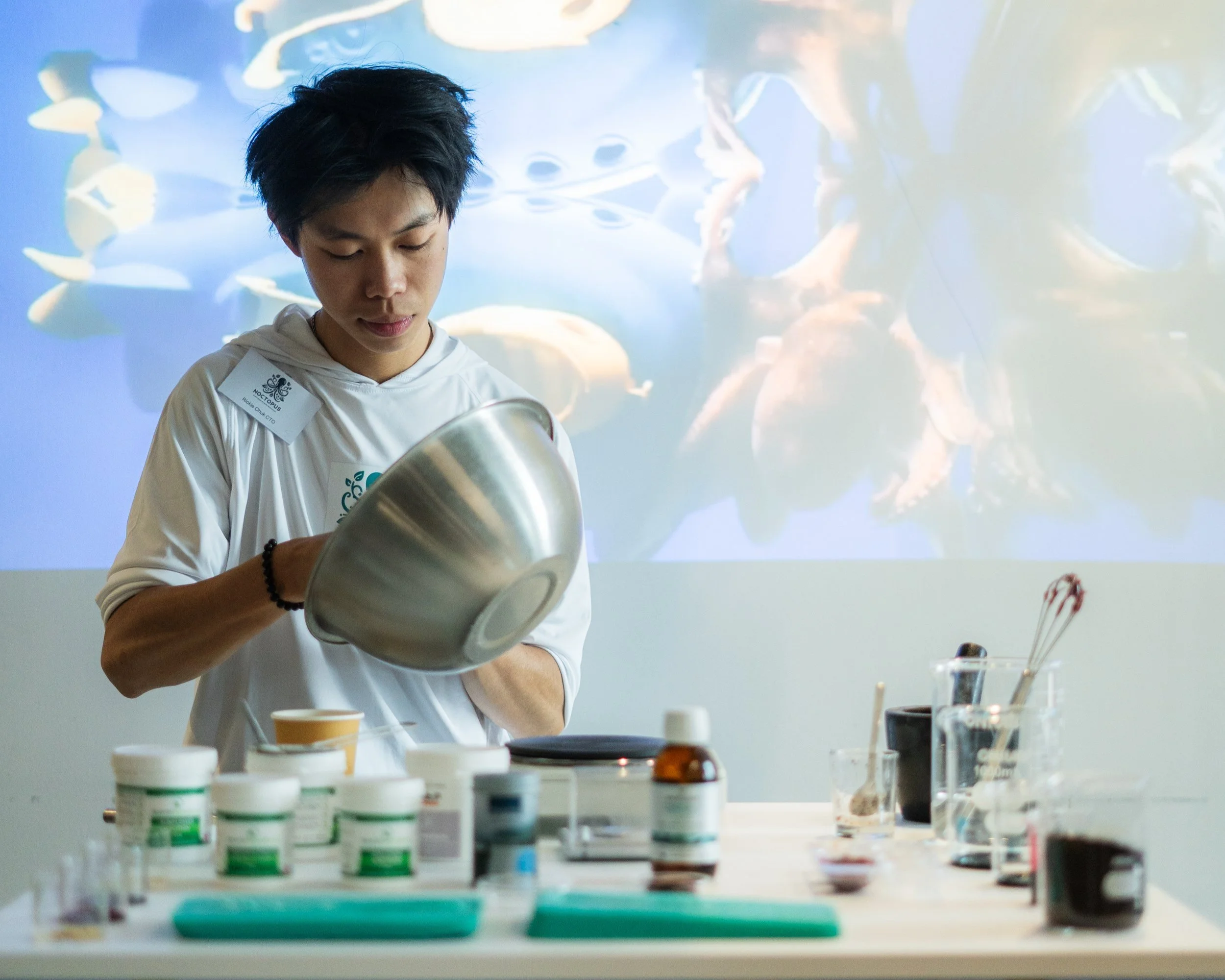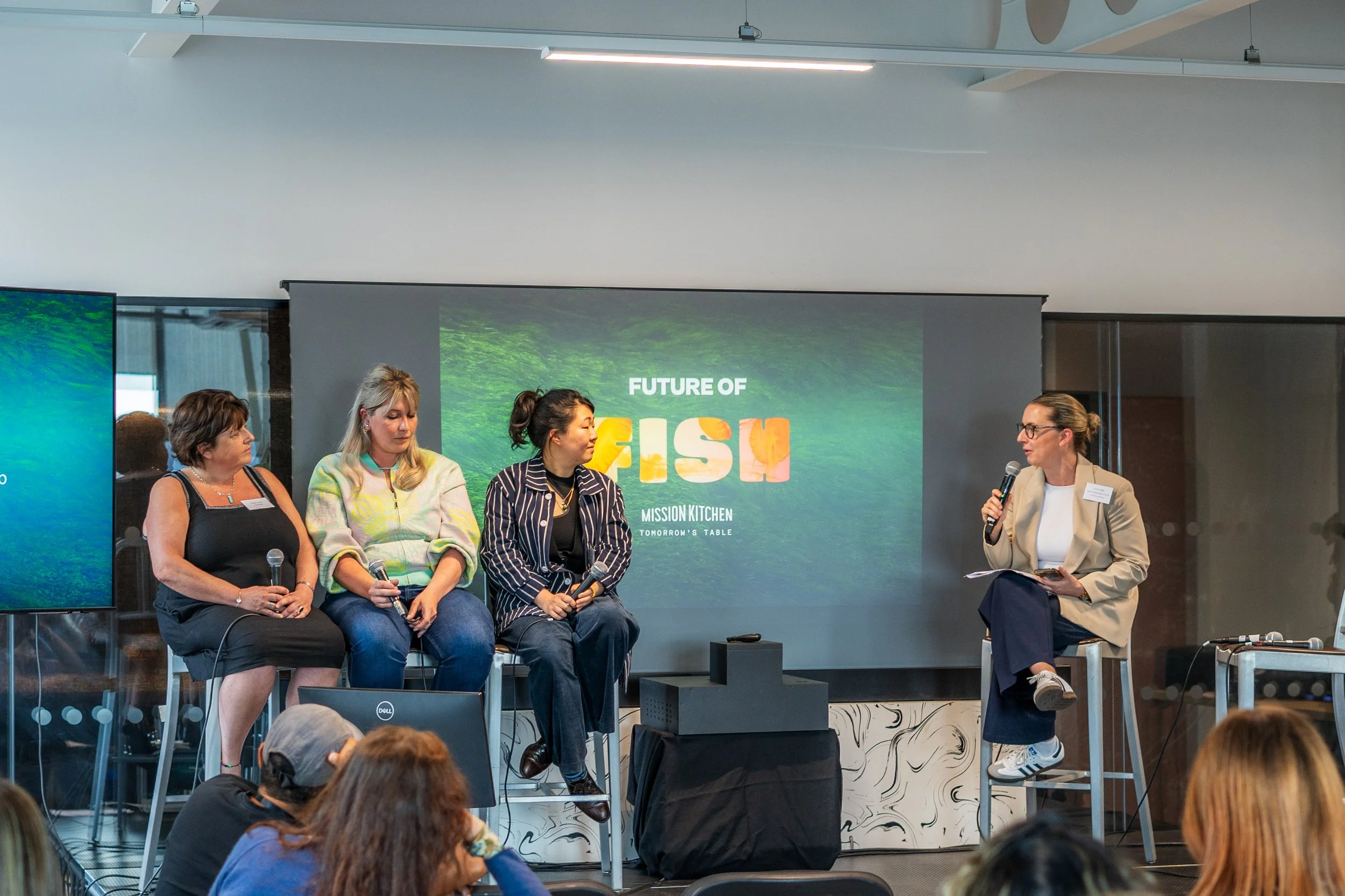Future of Fish: Debrief
On 23rd May 2024, over 100 food founders, chefs, innovators and campaigners came together at Mission Kitchen for a day dedicated to discovering the Future of Fish & Seafood.
Some argue that the only sustainable future is one where humans cease eating fish altogether. But that vision is unrealistic, the sourcing and consumption of fish and seafood are deeply rooted in culture, identity, and livelihoods, and provide a vital source of protein for millions of people worldwide.
Much like meat, populations of the future will continue to eat seafood. So the question is: how can we enjoy and consume this resource more consciously and responsibly, ensuring that it remains available for future generations?
This question lay at the heart of this multi-disciplinary event. Here is what we learned…
1.
Recirculating Aquaculture Systems (RAS) are key to providing for a future supply of good quality fish & seafood.
RAS technology create low stress, clean systems for species suitable to being farmed on land. Similar to being a good farmer, a good aquaculturist creating optimal environments will have healthy and plentiful produce.
We learned from 360 Aquaculture that it takes 90-100 days to grow tropical shrimp, which they do from their high-tech facility in Wales. They are the first business to supply the UK’s only truly fresh shrimp - we heard from founder James Fox-Davies that all shrimp currently imported to the UK and Europe are actually frozen and then defrosted (even if it is sold under the guide of “fresh”).
Shrimp (or prawns as we like to call them in the UK) are a worldwide favourite, so this choice to farm shrimp presents a great business opportunity for projects like 360 Aquaculture.
James Fox-Davies - 360 Aquaculture
Our guests also had the opportunity to sample farmed yellowtail, also known as hamachi, during our Art of Sushi workshop. Sourced from The Kingfish Company, sushi chef Izumi Nakamura used this highly prized species to demonstrate the art of professional fish slicing.
Izumi Nakamura - The Art of Sushi Workshop
2.
Mussels are a truly sustainable superfood
Offshore Shellfish’s project started as an experiment in a wheelbarrow, certainly humble beginnings for the humble mussel. Now Sarah Holmyard’s family-run business grows tonnes of rope-grown mussels off the coast of Brixham.
Their mussels are a true superfood, not only nutritionally, but for the environment they grow in too. Mussels are high in protein, zinc, omega 3 and selenium, and they remove carbon through their shells.
A true representation of the power of regenerative aquaculture, Offshore Shellfish’s farms aren’t just home to mussels - percebes, crabs, scallops and a diverse array of other species have found a home too.
Sarah Holmyard - Offshore Shellfish
3.
Technology is constantly improving wild-caught methods
Bycatch has long been a concern for fishermen, campaigners and consumers alike. But there are some fantastic businesses innovating and harnessing technology to help fishing vessels achieve more sustainable yields and a “clean catch”.
Although not speaking at Future of Fish, businesses like SafetyNet Technologies use catch cams, lights and sensors in their nets for more precise wild fishing. SmartTrawl have created an underwater robotic sorting device for the same purpose. And Insight 360 is using AI to map out the oceans to allow fishermen to avoid certain species.
4.
The UK market for canned fish & seafood is primed for growth
Tinned fish pioneers Sea Sisters are the first business to open a cannery in the UK since the 1940s. Speaking on our “Selling Ocean Foods” panel, co-founder Charlotte Dawe shared with us the romantic story of working with her chef husband Angus on creating a stunning range of craft canned fish - from sardine dolmades, to oak smoked trout, to kimchi whelks (90% of UK whelks get sent to Asia currently, as do the vast majority of UK sardines)
Diverse and luxury canned fish & seafood is not just for holidays - according to Charlotte, you’d most likely be eating British produce anyways, as sunny Europe is where most of our produce gets exported to!
With TikTok trends like “canned fish date night”, we hopefully will see British tinned fish elevated to its proper status in the near future.
Sea Sisters - British Conservas
5.
Small but mighty projects are changing the traditional fish finger
The FoodSEqual project, spearheaded by Caroline Bennett of Sole of Discretion, spoke about using underutilised species in the creation of a new generation of fish finger - one that would not only keep more fish in Plymouth, but also feed the communities surrounding the port.
But there are challenges of using less known species like dogfish, whiting, and pouting - from low yield, increased labour sorting the white meat from bone and skin, and achieving price parity with strict school budgets.
We hope to see a fantastic project like the Plymouth Fish Finger succeed and be replicated right across the coastal towns of the UK in the future.
Could food manufacturing behemoths like Nomad Foods (owners of the Bird’s Eye brand) reformulate their recipes to include these underutilised species? Or provide support to initiatives like FoodSEqual to achieve their ambitions?
6.
Plymouth could be the Barcelona of Britain
Also according to Caroline Bennett, in 2022, a whopping 95% of Plymouth landings were exported out of Plymouth. The UK is simply not enjoying our own harvests of the sea. If we were, coastal towns could become dining and tourist hotspots on par with cities like Barcelona or San Sebastian.
It’s ironic as fish & seafood is a short shelf product, but much of it travels long distances out of the UK in order to be sold. Producers are forced to sell to overseas markets to fetch a fair price for their catch - and this reality rings true even with farmed seafood businesses like Offshore Shellfish, who sell most of their bounty to Asia.
This is the reality of globalisation and the result of a very limited demand from UK consumers.
7.
“The Big 5” (cod, haddock, salmon, tuna and prawns) make up 80% of the fish and seafood we consume in the UK. Diversity could be the key in achieving a more sustainable - and interesting - future.
Chef Mircel McSween wowed guests with an interpretation of what a future Fish & Chips could look and taste like.
Hake, pollock and coley were encased in the crispiest batter - all species being a superb replacement for traditional, and under threat cod and haddock. We would love to see fish & chip shops around the UK taking a chance on these species.
Billingsgate veteran CJ Jackson also tested our guests' taste buds, putting head to head cured trout and cured salmon in our “Making Fish Fashionable” workshop.
CJ Jackson
We hope the chefs and restaurateurs in the room were inspired to diversify their menus - they all have huge purchasing power and influence on the consumer, and as chef and author Dan Barber would say, chefs are fundamentally environmentalists.
8.
Clean label plant-based fish alternatives - available through retail, restaurants and food service - are part of the journey to sustainability.
High quality food innovations like FoodSquared “prawns” and Squeaky Bean’s “smoked salmon” and “tuna” should ease the pressure off the Big 5. This should be seen as complementary to the fishing industry and not as a threat.
Progress like this gives consumers a choice, and with the rise and general acceptance of meat alternatives, the market is primed for more fish & seafood alternatives.
Colette Jessamy, Head of Product Development at Squeaky Bean noted in her talk that their plant-based smoked salmon is now the best selling product in their range.
But there's still a perception challenge from those consumers not quite convinced by plant-based fish & seafood. Short, clean ingredient lists need to be achieved, alongside familiarity - in terms of natural flavour, shape, colour and patterns.
Having tried Squeaky Bean’s plant-based tuna on our Ocean Current Banquet grazing table, we can confirm that they’ve nailed the texture and flavour - no easy feat!
9.
Co-fermentation of Mycelium & Microalgae could provide the key to high quality fish alternatives
Newer to the market are white fish fillet alternatives from startups like Koralo and Pacifico Biolabs. Harnessing the natural omega 3 and nutritional content and flavour of algae, partnered with textural quality of mycelium, they go through a fermentation process together to create muscle-like fibres consistent with ever-popular white fish fillets.
Koralo have focused on the Korean market primarily, due to their high consumption of fish-based products. We are looking forward to trialling both products once they reach the UK soon.
Could plant-based Octopus be next on the cards? “Noctopus” live art installation got the crowd talking.
10.
Fishing is a people-led industry. Its future depends on its people having respectable livelihoods that they can rely upon and feel proud of.
Charity leader Emma Plotnek of Fishing into the Future, made a passionate speech to our audience to make sure the voices of fishermen are heard at government level and scientific level. Those three areas, whilst being very different in areas of expertise and style of communication, need to work together to ensure that fishing can happen for future generations.
On the same “Water to Table” panel, SEA Alliance leader Georgia Worrall, reminded the audience that human rights are also at the centre of fishing practices. Usually affecting migrant workers, the most common human rights abuses at sea include being away from loved ones sometimes years at a time, without any communication.
Emma Plotnek - Fishing Into The Future
11.
Women are also part of powering a future fishing industry, from fisherwomen, to female fishmongers, to female chefs.
Ashley Mullenger is probably the most visible female fisherman in the country, utilising social media to highlight her work and through her book “My Fishing Life”. Her big takeaway to getting more women into fishing is to bring down the barriers to initial training costs, including the essential sea safety course (which mostly men attend in a swimming pool together).
Former Debenhams window dresser turned fishmonger Elaine Lorys is a true industry hero, having been the first woman to earn the title of master fishmonger. She is at her shop in Cornwall everyday convincing customers to take a chance on Cornish Sole (also known as Megrim) and King Crab (also known as Spider Crab), and providing recipe inspiration. Trust and support local fishmongers like Elaine - they know what’s best!
Former head chef of Margate restaurant Sargasso, Emily Chia, talked about responsive menu design when it comes to fish & seafood. Chefs can have the tendency to be rigid and conform to what they believe the consumer will like. But they can take a more creative stance to present to diners the best of the ocean bounty - from fish skin crisps, fish heads, to homemade garum.
And our evening networking was brought to life by twin fishmongers and shuckers Sista Shuck who provided our guests with the freshest Irish oysters.
When we see women being recognised in the fishing industry, their jobs become aspirational, high status, and offer bright career prospects to other women thinking of entering the industry.
Elaine Lorys, Ashley Mullenger, Emily Chia - Chaired by the MSC’s Loren Hiller
12.
We need a Cabinet Minister of the Sea
Our closing speaker Guy Standing provided a compelling and heartfelt end to Future of Fish. As a campaigning economist and prolific author, notably of “The Blue Commons: Rescuing the Economy of the Sea”, he called on the UK government to instate a new Minister of the Sea.
You can read his full speech here, outlining the key reasons why such a high level government position is essential to the Future of Fish.
With a new government potentially coming to power very soon, we hope to see more political attention on the sea, which is 27 times the UK’s land area. Proper stewardship at the highest government level is an essential part to ensuring a sustainable Future of Fish for future generations.
Guy Standing - Why we need a Cabinet Minister for the sea.












